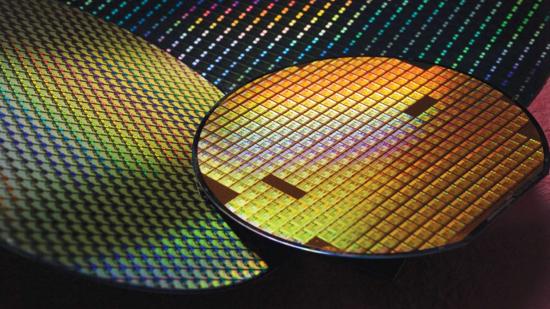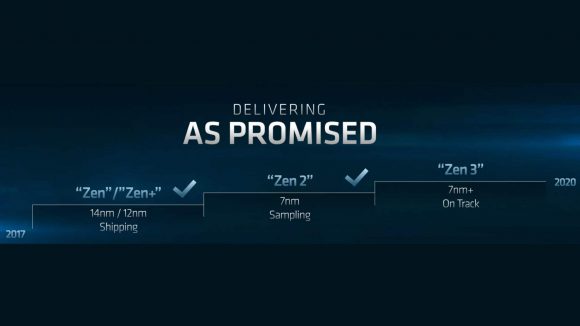We’re only just seeing high-end 7nm products filtering out into the world and yet TSMC will have 5nm chips (or N5 in its current parlance) spilling out of its factories in the first half of next year. Right now only the AMD Radeon VII is available as a genuine consumer-facing 7nm device. Albeit consumers with a whole heap of ready cash to splash on a new GPU… There will be 7nm CPUs from AMD soon, with the Ryzen 3000 series of processors (but not APUs) all set to launch on TSMC’s node this year.
But even though TSMC is preparing to produce 5nm chips in volume in 2020, the Zen 3 processors set to launch that year will be on the only slightly refined 7nm+ node. TSMC CEO, C. C. Wei, however, is confident that most of the company’s customers currently using the 7nm process will make the move to 5nm. Eventually.
“With the best density performance, power, and the best transistor technology,” Wei says on TSMC’s Q1 earnings call, “we expect most of our customers who are using 7nm today will adopt 5nm.”
But with the 7nm+ process already penned in by AMD for its Zen 3 and post-Navi GPU architecture, it’s going to be a little while before we actually see AMD silicon running on a 5nm design, at least on the CPU side.
Read more: These are the best CPUs for gaming today
Which is a shame as, while 7nm and 5nm don’t sound like anywhere near as big a jump in scale as the previous move from 14nm down to 7nm, there’s still a huge difference between the two nodes. And even between 6nm and 5nm. Yes, to confuse things even further TSMC has got a 6nm node, a node which is actually launching after 5nm.
But TSMC remains adamant that there will be no cannibalisation between the two for its customers.
“The number N6 and N5 looks pretty close,” says Wei, “but actually they still have a big gap. N5 compared with N7, actually, the logic density increases by 80%. N6 compared with N7 is only 18%. So you can see there’s a big difference in that logic density and transistor performance also. And so, as a result, the total power consumption in the chip is lower in the N5. There’s a lot of benefit if you move into N5.”
Yes, that means despite the transistor size being nominally very close, there is a huge amount of extra logic space available to chips designed on the 5nm process node. Now, just imagine how many CPU cores AMD could jam inside a 5nm chiplet if it has another 80% more transistor space to play with…
Will AMD’s Zen use 6nm or 5nm next?
So if the 6nm design is coming after the 5nm node has actually entered volume production, and is offering less transistor density, what’s the point? Well, the issue is that TSMC’s 5nm process is a whole new node, which means it doesn’t follow the same design rules as the 7nm node, and products would therefore need substantial redesigns to work on the different process… which is where the later 6nm comes in.
When foundries work on process nodes they also continue to work on derivatives, which is exactly what the 7nm+ and 6nm nodes are. They’re still based on the original 7nm design and as such chip designs will be 100% compatible with the slightly more advanced processes. Think 14nm moving on to the 12nm designs, where the 14nm RX 580 was pretty easily transitioned to the 12nm RX 590.
With 6nm offering 18% higher logic density, compared with the original 7nm node, it would seem like an easy performance boost to offer without requiring much in the way of extra effort for TSMC’s customers.
“The ecosystems are ready and equally mature with N6. Because we’re 100% compatible,” explains Wei. “Of course, you still have to do some modification. If you want to shrink your die, you have to rerun your timing, closure, those kind of things. But it’s still much easier from N7 go to N6, rather than N7 go to N5.”
Click here for more hardware video goodness
With 6nm then TSMC’s customers can re-use their 7nm, or 7nm+ designs, and still benefit from higher performance, greater density, and a shorter time to manufacture.
With all the different nodes available to customers, such as AMD, it will be interesting to see what impact that has on their product cycles. Will AMD continue to release a nominally new version of Zen every year?
We know that Zen 2 is coming this year, and that the Zen 3 design appearing in 2020 will use TSMC’s compatible 7nm+ design. But with 6nm arriving at the end of next year we could get a refreshed CPU lineup tagged as Zen 4 early in 2021 on the 6nm node, using essentially the same design as we’re getting in the Ryzen 3000 chips releasing this year.
Or we could instead get a completely new Zen design based on 5nm.
Given AMD’s leap-frogging design teams either option is possible. Its big brains could well be beavering away right now on a brave new Zen CPU design for TSMC’s 5nm process and, as we know its engineers have been working on Zen 5 for over a year, that might be a more appealing pairing for a whole new node.
Zen 4 could then just be that 6nm refresh, which would almost make the third and fourth generation Zen products feel rather less exciting than the first and second gen chips.
But as it’s going to be a while before Intel can even get its 7nm silicon out of its factories and into people’s PCs, AMD could be forgiven for holding its 5nm designs in reserve knowing it doesn’t need to keep barreling on down the process rabbit hole right now.


